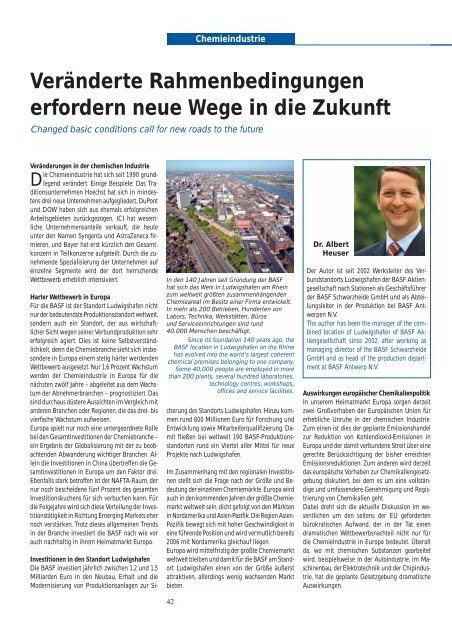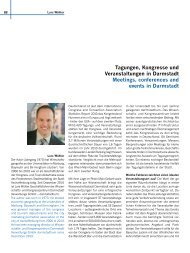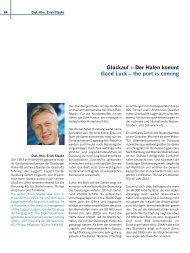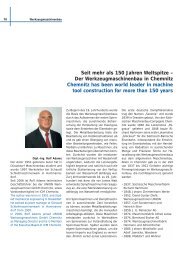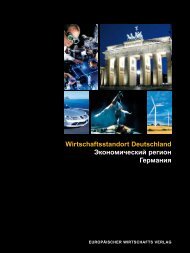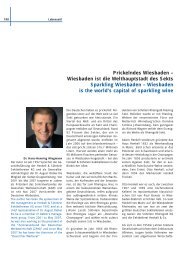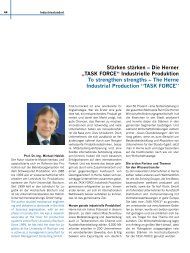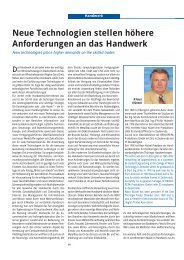PDF-Dowload
PDF-Dowload
PDF-Dowload
Sie wollen auch ein ePaper? Erhöhen Sie die Reichweite Ihrer Titel.
YUMPU macht aus Druck-PDFs automatisch weboptimierte ePaper, die Google liebt.
Chemieindustrie<br />
Veränderte Rahmenbedingungen<br />
erfordern neue Wege in die Zukunft<br />
Changed basic conditions call for new roads to the future<br />
Veränderungen in der chemischen Industrie<br />
Die Chemieindustrie hat sich seit 1990 grundlegend<br />
verändert. Einige Beispiele: Das Traditionsunternehmen<br />
Hoechst hat sich in mindestens<br />
drei neue Unternehmen aufgegliedert, DuPont<br />
und DOW haben sich aus ehemals erfolgreichen<br />
Arbeitsgebieten zurückgezogen, ICI hat wesentliche<br />
Unternehmensanteile verkauft, die heute<br />
unter den Namen Syngenta und AstraZeneca firmieren,<br />
und Bayer hat erst kürzlich den Gesamtkonzern<br />
in Teilkonzerne aufgeteilt. Durch die zunehmende<br />
Spezialisierung der Unternehmen auf<br />
einzelne Segmente wird der dort herrschende<br />
Wettbewerb erheblich intensiviert.<br />
Harter Wettbewerb in Europa<br />
Für die BASF ist der Standort Ludwigshafen nicht<br />
nur der bedeutendste Produktionsstandort weltweit,<br />
sondern auch ein Standort, der aus wirtschaftlicher<br />
Sicht wegen seiner Verbundproduktion sehr<br />
erfolgreich agiert. Dies ist keine Selbstverständlichkeit,<br />
denn die Chemiebranche sieht sich insbesondere<br />
in Europa einem stetig härter werdenden<br />
Wettbewerb ausgesetzt. Nur 1,6 Prozent Wachstum<br />
werden der Chemieindustrie in Europa für die<br />
nächsten zwölf Jahre – abgeleitet aus dem Wachstum<br />
der Abnehmerbranchen – prognostiziert. Das<br />
sind durchaus düstere Aussichten im Vergleich mit<br />
anderen Branchen oder Regionen, die das drei- bis<br />
vierfache Wachstum aufweisen.<br />
Europa spielt nur noch eine untergeordnete Rolle<br />
bei den Gesamtinvestitionen der Chemiebranche –<br />
ein Ergebnis der Globalisierung mit der zu beobachtenden<br />
Abwanderung wichtiger Branchen. Allein<br />
die Investitionen in China übertreffen die Gesamtinvestitionen<br />
in Europa um den Faktor drei.<br />
Ebenfalls stark betroffen ist der NAFTA-Raum, der<br />
nur noch bescheidene fünf Prozent des gesamten<br />
Investitionskuchens für sich verbuchen kann. Für<br />
die Folgejahre wird sich diese Verteilung der Investitionstätigkeit<br />
in Richtung Emerging Markets eher<br />
noch verstärken. Trotz dieses allgemeinen Trends<br />
in der Branche investiert die BASF nach wie vor<br />
auch nachhaltig in ihrem Heimatmarkt Europa.<br />
In den 140 Jahren seit Gründung der BASF<br />
hat sich das Werk in Ludwigshafen am Rhein<br />
zum weltweit größten zusammenhängenden<br />
Chemieareal im Besitz einer Firma entwickelt.<br />
In mehr als 200 Betrieben, Hunderten von<br />
Labors, Technika, Werkstätten, Büros<br />
und Serviceeinrichtungen sind rund<br />
40.000 Menschen beschäftigt.<br />
Since its foundation 140 years ago, the<br />
BASF location in Ludwigshafen on the Rhine<br />
has evolved into the world’s largest coherent<br />
chemical premises belonging to one company.<br />
Some 40,000 people are employed in more<br />
than 200 plants, several hundred laboratories,<br />
technology centres, workshops,<br />
offices and service facilities.<br />
Investitionen in den Standort Ludwigshafen<br />
Die BASF investiert jährlich zwischen 1,2 und 1,5<br />
Milliarden Euro in den Neubau, Erhalt und die<br />
Modernisierung von Produktionsanlagen zur Sicherung<br />
des Standorts Ludwigshafen. Hinzu kommen<br />
rund 800 Millionen Euro für Forschung und<br />
Entwicklung sowie Mitarbeiterqualifizierung. Damit<br />
fließen bei weltweit 190 BASF-Produktionsstandorten<br />
rund ein Viertel aller Mittel für neue<br />
Projekte nach Ludwigshafen.<br />
Im Zusammenhang mit den regionalen Investitionen<br />
stellt sich die Frage nach der Größe und Bedeutung<br />
der einzelnen Chemiemärkte. Europa wird<br />
auch in den kommenden Jahren der größte Chemiemarkt<br />
weltweit sein, dicht gefolgt von den Märkten<br />
in Nordamerika und Asien-Pazifik. Die Region Asien-<br />
Pazifik bewegt sich mit hoher Geschwindigkeit in<br />
eine führende Position und wird vermutlich bereits<br />
2006 mit Nordamerika gleichauf liegen.<br />
Europa wird mittelfristig der größte Chemiemarkt<br />
weltweit bleiben und damit für die BASF am Standort<br />
Ludwigshafen einen von der Größe äußerst<br />
attraktiven, allerdings wenig wachsenden Markt<br />
bieten.<br />
42<br />
Dr. Albert<br />
Heuser<br />
Der Autor ist seit 2002 Werksleiter des Verbundstandorts<br />
Ludwigshafen der BASF Aktiengesellschaft<br />
nach Stationen als Geschäftsführer<br />
der BASF Schwarzheide GmbH und als Abteilungsleiter<br />
in der Produktion bei BASF Antwerpen<br />
N.V.<br />
The author has been the manager of the combined<br />
location of Ludwigshafen of BASF Aktiengesellschaft<br />
since 2002, after working as<br />
managing director of the BASF Schwarzheide<br />
GmbH and as head of the production department<br />
at BASF Antwerp N.V.<br />
Auswirkungen europäischer Chemikalienpolitik<br />
In unserem Heimatmarkt Europa sorgen derzeit<br />
zwei Großvorhaben der Europäischen Union für<br />
erhebliche Unruhe in der chemischen Industrie.<br />
Zum einen ist dies der geplante Emissionshandel<br />
zur Reduktion von Kohlendioxid-Emissionen in<br />
Europa und der damit verbundene Streit über eine<br />
gerechte Berücksichtigung der bisher erreichten<br />
Emissionsreduktionen. Zum anderen wird derzeit<br />
das europäische Vorhaben zur Chemikaliengesetzgebung<br />
diskutiert, bei dem es um eine vollständige<br />
und umfassendere Genehmigung und Registrierung<br />
von Chemikalien geht.<br />
Dabei dreht sich die aktuelle Diskussion im wesentlichen<br />
um den seitens der EU geforderten<br />
bürokratischen Aufwand, der in der Tat einen<br />
dramatischen Wettbewerbsnachteil nicht nur für<br />
die Chemieindustrie in Europa bedeutet. Überall<br />
da, wo mit chemischen Substanzen gearbeitet<br />
wird, beispielsweise in der Autoindustrie, im Maschinenbau,<br />
der Elektrotechnik und der Chipindustrie,<br />
hat die geplante Gesetzgebung dramatische<br />
Auswirkungen.
Chemical Industry<br />
Changes in the chemical industry<br />
Since 1990, the chemical industry has undergone<br />
fundamental changes. For instance, the<br />
traditional company Hoechst was split up into at<br />
least three new companies, DuPont and DOW<br />
withdrew from formerly successful business areas,<br />
ICI sold substantial shares in the company, which<br />
today are run under the names of Syngenta and<br />
AstraZeneca, and Bayer has only recently divided<br />
Der Ausbau des Kombiverkehrsterminals<br />
der BASF Aktiengesellschaft in Ludwigshafen<br />
macht sichtbare Fortschritte:<br />
Das zweite Kranmodul schlägt seit<br />
Anfang 2005 in einem ersten Schritt weitere<br />
92.000 Ladeeinheiten pro Jahr um.<br />
The extension of the inter-modal transport<br />
terminal of BASF Aktiengesellschaft in<br />
Ludwigshafen is making noticeable progress:<br />
from the beginning of 2005, the second<br />
crane module has been handling<br />
another 92,000 TEUs annually.<br />
the overall group into sub-groups. The increasing<br />
specialization of companies in individual segments<br />
will considerably intensify the competition within<br />
these segments.<br />
Tough competition in Europe<br />
For BASF, the Ludwigshafen location is not only<br />
the most important production location worldwide,<br />
but, due to its combined production, it is also<br />
economically very successful. This is not a matter<br />
of course, because the chemical sector is facing<br />
an ever tougher competitive situation, especially<br />
in Europe. Growth projections for the chemical industry<br />
in Europe indicate only a moderate growth<br />
of 1.6 per cent for the next twelve years, derived<br />
from the growth rates of its customer industries.<br />
These prospects are indeed quite gloomy, compared<br />
to other sectors or regions where growth is<br />
three or four times as high.<br />
As a result of the globalization and the related<br />
exodus of major industries, Europe today is only<br />
of minor importance in terms of the total investment<br />
of the chemical industry. The investments in<br />
China alone are three times as high as the total<br />
investments in Europe. The NAFTA region is also<br />
strongly affected, achieving only a small proportion<br />
of five per cent of the overall investments. In<br />
the years to come, this shift of investment activities<br />
towards the emerging markets is likely to<br />
even intensify. In spite of this tendency prevailing<br />
in the chemical sector, BASF continues to make<br />
sustainable investments in its European domestic<br />
market, too.<br />
Investments in the Ludwigshafen location<br />
Each year, BASF invests between 1.2 and 1.5 thousand<br />
million euros in building, maintaining and<br />
upgrading production facilities to secure the Ludwigshafen<br />
location. Another 800 million euros are<br />
spent on research and development and on employee<br />
qualification. This means that, while BASF<br />
has 190 production locations worldwide, about<br />
one quarter of all funds for new projects go to<br />
Ludwigshafen.<br />
When talking about regional investments, one<br />
must take a look at the size and significance of the<br />
individual markets for chemical products. Europe<br />
will continue to be the world’s largest market for<br />
chemicals in the years to come, closely followed<br />
by the markets of North America and Asia-Pacific.<br />
The Asian-Pacific region is heading for a leading<br />
position at a high speed and will probably be<br />
on equal terms with North America by 2006.<br />
Europe will continue to be the world’s largest market<br />
for chemical products in the medium term,<br />
thus offering the BASF Ludwigshafen location a<br />
market which is very attractive in size though having<br />
only a small potential for growth.<br />
The effects of European chemicals policy<br />
Two major projects of the European Union are currently<br />
causing considerable unrest in the chemical<br />
industry of our European domestic market. In the<br />
first place, it is the planned trade with emissions<br />
in order to reduce the carbon dioxide emissions in<br />
Europe and the related controversy over a fair<br />
consideration of the emission reductions achieved<br />
so far. In the second place, the European project on<br />
chemicals legislation is being discussed, which is<br />
43<br />
dealing with a complete and more comprehensive<br />
approval and registration of chemical products.<br />
The current discussion mainly focuses on the bureaucratic<br />
expenditure required by the EU, which<br />
indeed represents a dramatic competitive disadvantage,<br />
not only for the European chemical industry.<br />
Wherever chemical substances are used,<br />
e. g. in the automotive industry, in mechanical engineering,<br />
in electrical engineering and in the<br />
chips industry, the planned legislation will have<br />
dramatic consequences.<br />
The Ludwigshafen location<br />
The Ludwigshafen location is unique in the world<br />
of chemical industry due to the interaction between<br />
numerous production facilities, infrastructure<br />
and service units, research units and managing<br />
functions. Thousands of different products are<br />
being manufactured here in a complex production<br />
network. The range of products includes processed<br />
products, for instance for the lacquer and leather<br />
industries, chemicals such as solvents, additives<br />
and high-quality special products, as well as a wide<br />
selection of plastic materials and even pesticides<br />
and nutritional products.<br />
In 2004, more than 8,000 products corresponding<br />
to some 8.5 million tons were produced at the Ludwigshafen<br />
location and shipped to customers all<br />
over the world by water, road and rail. This production<br />
performance as well as the economic success<br />
of the location can only be achieved with<br />
highly qualified staff. BASF Aktiengesellschaft<br />
currently (in 2005) employs approximately 35,000<br />
permanent staff members and some 5.000 external<br />
workers, which makes it by far the largest employer<br />
in the Rhine-Neckar Triangle.<br />
The Ludwigshafen location occupies an area of<br />
more than seven square kilometres, which would<br />
be sufficient to hold 1,500 football fields. The great<br />
number of buildings and production facilities is<br />
equally impressive – more than 200 factories cooperate<br />
in a close network, thus forming the aforementioned<br />
combined production system. This combined<br />
system becomes visually apparent in the pipe<br />
network, which has a length of 2,000 kilometres.<br />
The over 200 production facilities need large<br />
amounts of electricity, steam and cooling water:<br />
the annual power demand of the location of 6.2<br />
thousand million kilowatt hours equals that of a<br />
city with 1.5 million inhabitants. Each year 1.4<br />
thousand million cubic metres of cooling water<br />
are needed. The carbon dioxide emissions of the<br />
BASF Ludwigshafen location have been reduced<br />
by more than ten per cent over the past ten years,<br />
despite the increased production quantities. Besides<br />
various actions taken on-site, this is also due<br />
to the combined production system which helps<br />
save substantial amounts of fossil fuels.
Chemieindustrie<br />
Der Standort Ludwigshafen<br />
Das Zusammenspiel von zahlreichen Produktionsbetrieben,<br />
Infrastruktur- und Serviceeinrichtungen,<br />
Forschungseinheiten und Konzernlenkungsfunktionen<br />
macht den Standort Ludwigshafen in der<br />
Welt der Chemieindustrie einzigartig.<br />
Hier werden heute mehrere Tausend verschiedene<br />
Produkte in einem komplexen Produktionsnetzwerk<br />
hergestellt. Dabei reicht die Produktpalette<br />
von Veredelungsprodukten, zum Beispiel für die<br />
Lack- und Lederindustrie über Chemikalien, wie<br />
Lösemittel, Additive und hochwertige Spezialprodukte,<br />
sowie eine breite Palette an Kunststoffen bis<br />
hin zu Produkten aus dem Pflanzenschutz- und<br />
Ernährungsbereich.<br />
Am Standort Ludwigshafen wurden im Jahr 2004<br />
über 8.000 Produkte in einer Größenordnung von<br />
rund 8,5 Millionen Tonnen hergestellt und über<br />
Wasser, Straße und Schiene an ein weltweites Kundennetzwerk<br />
verschickt. Diese Produktionsleistungen<br />
wie auch der wirtschaftliche Erfolg des Standorts<br />
sind nur mit einer hoch qualifizierten Belegschaft<br />
zu erreichen. Zurzeit beschäftigt die BASF<br />
Aktiengesellschaft am Standort Ludwigshafen rund<br />
35.000 eigene und etwa 5.000 fremde Mitarbeiter<br />
(Stand: 2005) und ist damit der mit Abstand größte<br />
Arbeitgeber im Rhein-Neckar-Dreieck.<br />
Der Standort Ludwigshafen hat eine Fläche von<br />
über sieben Quadratkilometern und würde damit<br />
genügend Platz für 1.500 Fußballplätze bieten.<br />
Ebenso beeindruckend ist die große Zahl an Gebäuden<br />
und Produktionsbetrieben – denn über<br />
200 Fabriken arbeiten eng vernetzt und bilden<br />
den erwähnten Produktionsverbund. Sichtbar wird<br />
dieses Verbundsystem durch das 2.000 Kilometer<br />
lange Rohrnetzwerk.<br />
Die über 200 Produktionsbetriebe verbrauchen<br />
eine große Menge an Strom, Dampf und Kühlwasser:<br />
Der jährliche Strombedarf des Standorts<br />
liegt mit 6,2 Milliarden Kilowattstunden in der<br />
Größenordnung des Bedarfs einer Stadt mit 1,5<br />
Millionen Einwohnern. Der Bedarf an Kühlwasser<br />
beträgt pro Jahr rund 1,4 Milliarden Kubikmeter.<br />
In den vergangenen zehn Jahren wurden die Kohlendioxid-Emissionen<br />
der BASF am Standort Ludwigshafen<br />
trotz gestiegener Produktionsmengen<br />
um mehr als zehn Prozent reduziert. Dies ist neben<br />
den verschiedenen Maßnahmen vor Ort auch<br />
auf das Verbundkonzept zurückzuführen, durch<br />
das erhebliche Mengen an fossilen Brennstoffen<br />
geschont werden.<br />
Das Standortprojekt Ludwigshafen – neue Wege<br />
in die Zukunft am Standort Ludwigshafen<br />
Unser Ziel ist es, die BASF auch in Zukunft als<br />
erfolgreiches, eigenständiges Unternehmen mit<br />
eigener Identität zu erhalten, und das können wir<br />
nur erreichen, wenn der für die BASF bedeutendste<br />
Produktionsstandort Ludwigshafen im weltweiten<br />
Vergleich eine Spitzenstellung einnimmt. Die<br />
hierfür notwendigen Veränderungen müssen wir<br />
heute angehen. Dazu bedarf es erheblicher Anstrengungen.<br />
Im Standortprojekt Ludwigshafen,<br />
das im Oktober 2002 startete, haben wir bereits<br />
viele Änderungen umgesetzt.<br />
Zunächst hat sich der Standort Ludwigshafen eine<br />
klare Struktur gegeben. Das Stammwerk zeichnet<br />
sich dadurch aus, dass dort neben den Produktionsanlagen<br />
und der dazugehörigen Infrastruktur<br />
auch eine Vielzahl übergeordneter Einheiten wie<br />
Konzernlenkungsfunktionen, globale Geschäftseinheiten<br />
und die Forschung ansässig sind.<br />
Der Produktionsstandort hat zugleich eine eigenständige<br />
Führungsstruktur bekommen, mit dem<br />
Werksleiter an der Spitze. Die Werksleitung ist die<br />
Interessenvertretung des Produktionsstandortes<br />
nach innen und nach außen und übernimmt zudem<br />
Steuerungsfunktionen für die Aktivitäten in<br />
Produktion und lokalen Service- und Infrastruktureinrichtungen<br />
am Standort.<br />
Unter dem Stichwort „Mehr Markt“ wurden die<br />
Spielregeln zwischen internen Dienstleistungseinheiten<br />
und internen Abnehmern dieser Dienstleistungen<br />
neu geregelt, und zwar so, als würden die<br />
Partner eine marktübliche Vereinbarung über<br />
Lieferung und Leistung abschließen – mit allen<br />
Rechten, aber auch Pflichten.<br />
Bisherige Leistungen der Dienstleister wurden in<br />
Serviceprodukten zusammengefasst. Marktgängige<br />
Serviceprodukte ermöglichen externe Vergleiche.<br />
Zur Sicherstellung der Wettbewerbs- und Innovationsfähigkeit<br />
werden regelmäßige und faire Vergleiche<br />
mit dem externen Markt durchgeführt.<br />
Wenn Service- und Infrastrukturprodukte auf Dauer<br />
nicht wettbewerbsfähig sind, werden entsprechende<br />
Maßnahmen bis hin zur Fremdvergabe<br />
geprüft.<br />
Auch in der Produktion gibt es neue Instrumente,<br />
mit deren Hilfe die Produktivität gesteigert werden<br />
soll. So soll der verstärkte Einsatz IT-gestützter<br />
Methoden bei den größten Kostenblöcken,<br />
nämlich bei den Einsatzstoffen, bei der Energie<br />
und verborgenen Kapazitätsreserven ansetzen<br />
und durch optimierte Fahrweisen die Wirtschaftlichkeit<br />
der Anlagen erhöhen. Um auch bei der<br />
Nutzung der Flächen am Standort wirtschaftlicher<br />
zu werden, wurde ein zentrales „Property Management“<br />
gegründet. Es stellt sicher, dass Flächen<br />
und Gebäude bedarfsgerecht zugewiesen werden.<br />
Daneben haben wir eine zentrale Einheit „Ansiedlungsmanagement“<br />
gegründet, um den Verbund<br />
gezielt für geeignete Partner zu öffnen. Kernaufgabe<br />
der Einheit ist die Ansiedlung geeigneter Kooperationspartner<br />
am Standort Ludwigshafen. Bedingung<br />
für eine erfolgreiche Ansiedlung ist, dass<br />
sowohl Partnerunternehmen als auch die BASF<br />
44<br />
Wettbewerbsvorteile erzielen und der Verbund<br />
insgesamt gestärkt wird.<br />
Die Wettbewerbsfähigkeit von Ludwigshafen wird<br />
durch alle genannten Maßnahmen erheblich gesteigert.<br />
Gleichzeitig erhöht dies die Attraktivität<br />
des Standorts für zukünftige Investitionen in neue<br />
Anlagen, die letztlich neben aller Steigerung der<br />
Effizienz in den vorhandenen Abläufen die Zukunftsfähigkeit<br />
des Standorts sichern.<br />
Positive Bilanz<br />
nach 24 Monaten Standortprojekt<br />
Nach rund zwei Jahren Standortprojekt ziehen wir<br />
eine sehr ermutigende Bilanz. Auf dem Weg zu unserem<br />
Ziel, nachhaltig 450 Millionen Euro pro Jahr<br />
einzusparen, liegen wir voll im Plan.<br />
Wir haben die Effizienz am Standort Ludwigshafen<br />
gesteigert und damit eine Voraussetzung für<br />
einen erfolgreichen Weg in die Zukunft geschaffen.<br />
Um auf lange Sicht Erfolg zu haben, braucht<br />
die Industrie aber auch Rahmenbedingungen innerhalb<br />
der EU und in Deutschland, die Unternehmensaktivitäten<br />
fördern und nicht behindern.<br />
Auch hierfür setzen wir uns in vielen Gremien und<br />
Verbänden ein. Und dies nicht nur für uns selbst,<br />
sondern für die gesamte produzierende Industrie<br />
in Deutschland und der EU. Denn die chemische<br />
Industrie ist wie keine andere Industrie eine Querschnittsindustrie<br />
und in der Lage, durch ihre Forschung,<br />
Entwicklung und ihre Produkte den Erfolg<br />
anderer Industriezweige mitzugestalten. ■
Chemical Industry<br />
Die neue Citral-Anlage<br />
auf dem Werksgelände<br />
der BASF Aktiengesellschaft<br />
in Ludwigshafen<br />
liefert den<br />
Schlüsselbaustein<br />
der BASF-Feinchemie:<br />
Citral ist Ausgangsstoff<br />
für die Vitamine A<br />
und E, Carotinoide<br />
sowie verschiedene<br />
Aromachemikalien.<br />
The new Citral facility<br />
at the BASF Aktiengesellschaft<br />
premises in<br />
Ludwigshafen provides<br />
the key element for<br />
BASF refined chemical<br />
products. Citral is the<br />
primary material of the<br />
vitamins A and E,<br />
carotinoides and various<br />
flavour chemicals.<br />
increase the attractiveness of the location for future<br />
investments in new facilities which, besides<br />
the increased efficiency of existing work processes,<br />
are necessary to secure the future profitability<br />
of the location.<br />
Mit Chemikalien für Wet-End und Streicherei<br />
der BASF ist die neue Papiermaschine von<br />
LEIPA in Schwedt/Oder erfolgreich angefahren.<br />
Das Bild zeigt die Herstellung von Papierchemikalien<br />
bei der BASF am Standort Ludwigshafen.<br />
The new paper machine of LEIPA in Schwedt<br />
on the Oder successfully started operating with<br />
BASF chemicals for wet-end and spreading.<br />
The photo shows the production of paper<br />
chemicals at the BASF Ludwigshafen location.<br />
The Location Project Ludwigshafen –<br />
new roads to the future<br />
It is our aim to maintain BASF as a successful, independent<br />
company with an identity of its own also<br />
in the future. We will only be able to achieve this<br />
aim if the company’s most important manufacturing<br />
location of Ludwigshafen has a top position in<br />
international ranking. The changes necessary to<br />
achieve this purpose must be addressed today.<br />
This will require large efforts. Many changes have<br />
already been implemented within the Location<br />
Project Ludwigshafen, initiated in October 2002.<br />
First of all, the Ludwigshafen location has developed<br />
a clear structure for itself. The headquarters<br />
are characterized by the fact that many cross-functional<br />
units such as group management functions,<br />
global business units and the research centre are<br />
located here besides the production plants and<br />
their related infrastructure.<br />
At the same time, the production location was given<br />
an independent management structure, headed<br />
by the plant manager. The plant management represents<br />
the interests of the production location internally<br />
and externally, and moreover assumes<br />
control tasks for the activities in production and<br />
local service and infrastructure facilities.<br />
According to the slogan “more market”, the guidelines<br />
applicable in the relationship between internal<br />
service units and internal customers asking for<br />
their services were re-defined in such a way that<br />
both partners make agreements on supplies and<br />
services similar to usual market terms and including<br />
all rights and obligations.<br />
All services rendered<br />
by the service providers<br />
so far were combined<br />
to service products.<br />
Marketable service products allow for external<br />
comparisons. Regular and fair comparisons with<br />
external market conditions are conducted in order<br />
to ensure competitive and innovative capacities. If<br />
service or infrastructure products are not competitive<br />
in the long term, adequate action is considered,<br />
including purchase from external sources.<br />
In production, too, new tools have been introduced<br />
to help increase productivity. The intensified use<br />
of IT-based methods for instance, shall address<br />
the major cost blocks, i.e. material input, energy<br />
consumption and hidden capacity reserves, and<br />
through optimizing the operation of machines and<br />
other devices, shall increase the efficiency of the<br />
facilities. A central “Property Management” function<br />
was established to facilitate a more efficient<br />
utilization of space at the location. It makes sure<br />
that space and buildings are allocated according to<br />
actual needs.<br />
In addition, we established a central “Location<br />
Management” unit to initiate a targeted opening<br />
of the combined production system to adequate<br />
partners. The core task of this unit is to encourage<br />
adequate cooperation partners to set up businesses<br />
at the Ludwigshafen location. The precondition<br />
for any successful cooperation of that kind is that<br />
both the partner company and BASF will achieve<br />
competitive advantages and that the combined<br />
system as a whole will be strengthened.<br />
All the aforementioned measures will contribute<br />
to substantially improving the competitiveness of<br />
BASF Ludwigshafen. At the same time this will<br />
45<br />
Positive results 24 months<br />
after starting the Location Project<br />
About two years after starting the Location Project<br />
Ludwigshafen, we find the outcome very encouraging.<br />
With regard to our aim to save 450 million<br />
euros annually in the long term, we are fully in<br />
compliance with the schedule.<br />
We have increased the efficiency of the Ludwigshafen<br />
location and have thus created a favourable<br />
basis to set us on a successful road to the future.<br />
To be successful in the long term, however, the industry<br />
also needs basic conditions within the EU<br />
and in Germany which promote business activities<br />
instead of hindering them.<br />
We are actively supporting this goal in many bodies<br />
and associations. And we do not only do it for<br />
our own sake, but for the sake of the whole manufacturing<br />
industry in Germany and in the EU. Because<br />
the chemical industry, being a cross-sectoral<br />
industry, can more than any other business line<br />
contribute to the success of other industry branches<br />
with its research and development activities<br />
and products.<br />
■


